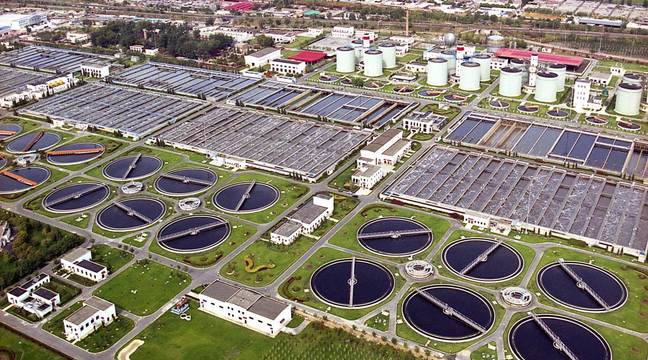
当前课程知识点:Water and Wastewater Treatment Engineering: Biochemical Technology > Chapter 5 Wastewater Anaerobic Biological Treatment Process > Section 5.6 Operation management of anaerobic biological treatment process > Section 5.6 Operation management of anaerobic biological treatment process
返回《Water and Wastewater Treatment Engineering: Biochemical Technology》慕课在线视频课程列表
返回《Water and Wastewater Treatment Engineering: Biochemical Technology》慕课在线视频列表
同学们好!下面我们来学习第五章的最后一节
厌氧生物处理工艺的运行管理
主要内容有三个,即厌氧生物处理装置的启动运行
第二是,运行管理指标,第三是水质管理指标
关于厌氧生物处理装置的启动运行,我们分为两部分来介绍
首先,介绍污泥厌氧消化池的投产启动
在消化池的投产运行之前,需要进行清水试验
检查消化池是否漏水,以及是否漏气
随后,就可以向消化池中投放接种污泥
通常是来自于其他已经成功运行的厌氧消化池中的厌氧污泥
一般呢,需要通过滤网进行过滤
投加接种污泥后,就可以开始少量投加浓缩后的生污泥
并开始测量产气量、沼气成分
以及出泥中间的pH值和上清液中间的VFA等指标
最后逐渐增加投泥量,一般需要50到60天才能够达到设计负荷
第二呢,是关于UASB反应器的投产启动
一般呢,可以分为两种方式,一种呢,是称为直接启动
就是直接采用足够量的颗粒污泥启动运行UASB反应器
但是呢,当没有合适的或者是这个足够量的颗粒污泥接种启动反应器的时候呢
可以采用厌氧消化污泥接种
一般要求接种污泥量在10到20kgVSS/m3
在启动运行时
一般要求将污泥负荷控制在0.1到0.2kgCOD/(kgSS·d)之间
容积负荷呢,应该小于0.5kgCOD/(m3·d)
同时呢,需要将水力负荷控制在一定的范围
使反应器内的水力上升流速呢,大于1m3/(m2·d)
当大于0.25 m3/(m2·h)的时候呢,在反应器内呢
就能够产生这个足够的水力分级作用,能够淘汰一些惰性的这个污泥
那么当进水浓度过高的时候,我们可以采用出水回流
对进水的COD进行一定的稀释,当整个反应器运行过程中间
通过水质监测,发现溶解性的COD的去除率大于80%以后呢
就可以逐渐开始提高负荷,同时呢,在这个过程中间
还需要对出水中间的VFA进行监测
希望呢,将VFA的浓度呢,要控制在1000mg/L以下
那么关于UASB反应器的运行呢
我们可以看出这个颗粒污泥的培养是其成功运行的关键
所以呢,在这简单的来介绍一下UASB反应器中间颗粒污泥的培养
那么从厌氧的硝化污泥,或者其他的絮状的厌氧污泥接种启动
在厌氧反应器中间培养出颗粒污泥呢,一般需要一到三个月
那么一般呢,可以分为启动期、颗粒污泥形成期和颗粒污泥成熟期
那么我们对接种污泥呢,要做一些选择
通常呢,我们可以采用厌氧污泥消化池中间的厌氧污泥作为接种
在培养过程中间,要维持稳定的环境条件,像水温,pH值等
同时呢,需要将这个污泥负荷呢,控制在0.05到0.1 kgCOD/(kgSS·d)左右
而将容积负荷呢,控制小于0.5 kgCOD/(m3·d)
要设法保持反应器中间非常低的VFA的浓度
表面的水力负荷呢,应该大于0.3 m3/(m2·d)
这样呢,淘汰一些絮状的污泥
进水中间呢,可以适当的提供一些无机的微粒
像一些钙或者是铁,同时必要的时候呢还可以适当的补充
一些微量的金属元素,如Ni、Co、Mo等
那么促进呢,产甲烷细菌的生长,促进颗粒污泥的形成
在实际的生产性的装置中间,颗粒污泥的形状多种多样
通常当然是球状的,但是呢,也有一些卵形的,或者长丝状的这样的颗粒污泥
它的平均的粒径是在1个毫米,一般呢,是在0.1到2个毫米
甚至最大的可以在5个毫米左右,那么颜色呢,可以是多种多样
当然,最常见的是黑色的颗粒污泥
但是也有灰色的,灰白色的
甚至呢,还有黄色的,或者是铁红色的这样的颗粒污泥
颗粒污泥的组成呢,实际上是由微生物,无机物
以及呢,一些胞外的多聚物等组成
那么它的VSS/SS一般呢,是在0.7到0.9之间
其中的微生物呢是主体,那么包括呢,水解发酵菌、产氢产乙酸菌、产甲烷菌
以及呢,其他的一些像硫酸盐还原菌
总的细菌的总数呢,大概是在(1到4)×10^12个/gVSS
那么其中主要的产甲烷细菌呢
有索氏产甲烷丝菌、或者是马氏或者是巴氏甲烷八叠球菌
从元素组成上来看,C、H、N的比例呢
大概碳呢,能够占到40%到50%,氢呢,大概是7%,氮的含量呢,大概是10%
颗粒污泥中间还含有很多无机的灰分物质
那么灰分的含量呢,受接种污泥以及进水水质等因素的影响
一般呢,是在8%到55%之间
其中的FeS、CaCO3等物质对于颗粒的稳定性有很重要的作用
那么特别是在颗粒污泥的形成初期呢
对于颗粒污泥的加快行程呢,有一定的帮助
第二点,是关于运行管理指标
当厌氧反应器完成启动运行后,就进入日常的运行管理
在这期间,需要经常对反应器的运行状况进行评价
这就需要呢,日常的测试一些运行参数作为评价运行状况的指标
这些指标主要有:处理的效果,即反应器进出水水质指标,如COD、BOD等
在厌氧反应器的运行中,最主要的指标是COD,那么还需要计算出COD的去除率
其次呢,需要计算出反应器的有机负荷,并与设计负荷进行对比
不能超负荷运行,还有就是要计算反应器的水力停留时间
还应每天监测厌氧反应器的产气量以及沼气的组成成分
在一段较长的运行时间之后,还应对厌氧反应器的剩余污泥的产量进行计算
那么第三呢,是关于水质管理指标
当采用厌氧反应器处理有机工业废水的时候
还应对各项水质指标进行日常的监测,以便对反应器的运行状况进行评价
主要的监测指标有:进水量,进水和出水的水质
包括:COD、BOD、SS、pH值、VFA、温度等
还要对反应器内的污泥浓度呢,进行跟踪监测
并对产气量、沼气成分进行监测
好,这一节的内容就到这,谢谢
-Section 0.1 Development Status of Wastewater Treatment Process
--Section 0.1 Development Status of Wastewater Treatment Process
-Section 0.2 Typical Processes of Wastewater Biological Treatment
--Section 0.2 Typical Processes of Wastewater Biological Treatment
-Section 1.1 Principles of wastewater aerobic biological treatment
--1.1 Principles of wastewater aerobic biological treatment
-Section 1.2 Principles and determination of wastewater biodegradability
--1.2 Principles and determination of wastewater biodegradability
-Section 1.3 Principles of wastewater anaerobic biological treatment
--Section 1.3.1 Principles of wastewater anaerobic biological treatment(1)
--Section 1.3.2 Principles of wastewater anaerobic biological treatment(2)
-Section 1.4 Principles of wastewater biological nitrogen removal
--Section 1.4 Principles of wastewater biological nitrogen removal
-Section 1.5 Principles of wastewater biological phosphorus removal
--Section 1.5 Principles of wastewater biological phosphorus removal
-Chapter 1 Homework
-Section 2.1 Basic concept of activated sludge process
--Section 2.1.1 Basic concept of activated sludge process
--Section 2.1.2 Basic concept of activated sludge process
-Section 2.2 Growth rule of activated sludge and its application
--Section 2.2 Growth rule of activated sludge and its application
-Section 2.3 Running mode of activated sludge process
--Section 2.3.1 Running mode of activated sludge process(1)
--Section 2.3.2 Running mode of activated sludge process(2)
-Section 2.4 Kinetics of active sludge process
--Section 2.4.1 Kinetics of active sludge process(1)
--Section 2.4.2 Kinetics of active sludge process(2)
--Section 2.4.3 Kinetics of active sludge process(3)
--Research and Development of Kinetic Model of Activated Sludge Process
-Section 2.5 Principle, calculation and equipment of aeration
--Section 2.5.1 Principle, calculation and equipment of aeration(1)
--Section 2.5.2 Principle, calculation and equipment of aeration(2)
-Section 2.6 Designing of activated sludge process
--Section 2.6 Designing of activated sludge process
-Section 2.7 Operation and management of active sludge process
--Section 2.7.1 Operation and management of active sludge process (1)
--Section 2.7.2 Operation and management of active sludge process (2)
-Chapter 2 Homework
-Section 3.1 Basic principle of biofilm
--Section 3.1 Basic principle of biofilm
-Section 3.2 Biofilter process
--Section 3.2.1 Biofilter Process (1)
--Section 3.2.2 Biofilter process (2)
--Section 3.2.3 Biofilter process (3)
-Section 3.3 Biodisk process
-Section 3.4 Biological contact oxidation process
--Section 3.4 Biological contact oxidation process
-Section 3.5 Aerobic biological fluidized bed process
--Section 3.5 Aerobic biological fluidized bed process
-Chapter 3 Homework
-Section 4.1 Oxidation ditch process
--Section 4.1 Oxidation ditch process
-Section 4.2 A-B process
-Section 4.3 SBR process
-Section 4.4 MBR process
-Chapter 4 Homework
-Section 5.1 Overview and characteristics of development of anaerobic biological treatment
--Section 5.1 Overview and characteristics of development of anaerobic biological treatment
-Section 5.2 Anaerobic digester
--Section 5.2 Anaerobic digester
-Section 5.3 Anaerobic contact process and anaerobic filter process
--Section 5.3 Anaerobic contact process and anaerobic filter process
-Section 5.4 UASB process
-Section 5.5 Other anaerobic biological treatment process
--Section 5.5 Other anaerobic biological treatment process
-Section 5.6 Operation management of anaerobic biological treatment process
--Section 5.6 Operation management of anaerobic biological treatment process
-Chapter 5 Homework
-Section 6.1 Introduction
-Section 6.2 Biological nitrogen removal process and technology
--Section 6.2 Biological nitrogen removal process and technology
-Section 6.3 Biological phosphorus removal process and technology
--Section 6.3 Biological phosphorus removal process and technology
-Section 6.4 Simultaneous nitrogen and phosphorus removal process
--Section 6.4 Simultaneous nitrogen and phosphorus removal process
-Chapter 6 Homework
-Section 7 Natural biological treatment process
--Section 7 Natural biological treatment process
-Chapter 7 Homework
-Section 8.1 Source, nature and treatment of sludge
--Section 8.1 Source, nature and treatment of sludge
-Section 8.2 Sludge thickening and digestive stability
--Section 8.2 Sludge thickening and digestive stability
-Section 8.3 Sludge conditioning, dehydration and incineration
--Section 8.3 Sludge conditioning, dehydration and incineration
-Chapter 8 Homework
-Section 9 Wastewater Discharge and Reuse
--Section 9 Wastewater Discharge and Reuse
-Chapter 9 Homework




